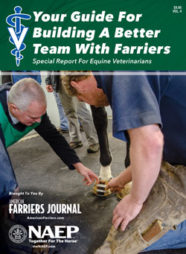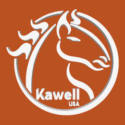Being successful will mean different things to each person and the pictures of success will change as you go through different stages of life. Just as life has different stages, every small business will go through different stages of growth.
In an article on studies of small businesses for the Harvard Business Review, Neil C. Churchill and Virginia L. Lewis found that small businesses experience five stages of growth.
- Existence. Simply come into being.
- Survival. Survive at all costs to make it to another day.
- Success. Maintain a profitable status quo or increase resources for growth.
- Take off. Experiencing growth.
- Resource maturity. Managing and reaping the return on investment (ROI).
Each stage will have areas that have key factors to overcoming those stages. This article will examine them from a farrier’s viewpoint.
Farrier Takeaways
- The five stages of growth provide a road map for small businesses.
- Problems can be prevented before they occur by using a proactive management style.
- Prepare for retirement by saving money consistently.
There are also eight key management factors that affect success or failure. Four of the factors are related toward the business and four toward the owner. These factors play an important role because your response could determine your advancement, if in fact that you do.
The business-related factors are as follows.
1 Financial resources. This pertains to the financial health of the company. Did you have to borrow money and climb out of debt to pay back the money? Or did you have the cash to start in the black?
2 Personnel resources. This pertains to how many people are working in the business. Granted, most farriers work with a skeleton crew. Every farrier only has so many horses in them, so spreading out the work load as it increases will extend your career.
3 System resources. This pertains to how the business is run, the planning and daily efficiency of the work.
4 Business resources. This pertains to customer relations and reputation within the industry.
The owner-related factors are as follows.
1 Owner’s goal setting, both personal and business. Goals are like a compass, they help orientate the direction that should be traveled.
2 Owner’s ability to do what has to be done and wear more than one hat. The owner will be in charge of marketing, inventory, scheduling and producing the work.
3 Owner’s willingness and ability to delegate. As workload increases from growth, some jobs need to be delegated to play to everyone’s strengths.
4 Owner’s ability to be future goal orientated and to be aware of the strengths and weaknesses of the company. As the company grows, the owner must be able to recognize its strengths and weaknesses, matching goals with its strengths and weaknesses.
As the five stages are discussed, keep in mind these eight key management factors as they will be re-visited several times throughout the stages.
Stage 1: Existence
Businesses all have a “start date.” Generally, businesses all start with someone’s idea and a vision to fill a need, whether it’s a need in the industry or to simply put food on the table.
Point 1: Startup costs. The money needed to start a farrier practice will be determined by your plans. Acquiring a full set of tools to shoe horses can cost thousands of dollars. Start with a basic rig. You only need a vehicle that will get you from point A to B. Start small but think big. Set some goals for the rig you want down the road. If you don’t have the money now, buy the tools needed to trim a horse and save for the big ticket items such as a forge and anvil.
While starting your new farrier business, it might be necessary to have a part-time job to supplement cashflow.
Point 2: Obtaining clients. The decision to start a farrier practice is easy enough to make, but the clients the practice serves is what solid-i-fies it. Here are some strategies to attract clients:
Business cards and flyers are the cheapest forms of advertisement. Leave these cards everywhere, including at the restaurant table with the tip. People might throw them away, but these cards might find their way into a potential client’s hands.

Mentors will help guide, encourage and support you on your business and life journey. They also will steer you back on track when you veer off the path you’ve set.
Word of mouth is the best form of advertisement. Generally, it requires that a client have experience with your business. Since clients are in short supply and you’re developing your reputation, relying on this early on can leave you wanting.
To jump start your reputation, get to know the local equine professionals. Offer to ride along with veterinarians on their farm calls or ask to spend some time at their hospital reviewing cases with them. If clients meet you with their trusted veterinarian or other equine professional, they’re more likely to trust you.
Ride along with established farriers, even if it’s for a day or two. Young farriers have an advantage over established farriers time. You can market, replace lost shoes and work on forging skills during the day rather than at night after a long day’s work.
Offer to be the on-call or on-site farrier for local schooling shows. Most cannot pay for an established farrier. You’ll be surprised how many people’s interest is piqued when they hear an anvil ringing. Offer to set up a booth during career days at schools. This might not seem like a prime client gathering venue, but it provides a chance to practice speaking with confidence and command of our content and trade.
Social media is free and most marketing advice will suggest that you create an “online presence.” Be careful with how you use these platforms. Keep business account posts educational and focus on your work.
Point 3: Location. Where you begin your farrier business can be critical in how affluent it will become. There are some areas that simply cannot sustain a farrier because of the lack of horses in the area. This seems to be the case in rural America. A farrier must travel longer distances to fill the books than if they lived in an area that has a bounty of horses. When considering where you want to establish your farrier practice, research the average income and cost of living. This is where setting prices should start.
Stage 2: Survival
Point 1: Cash flow. This is the total money being transferred in and out of a business. The balance between money in and money out is not even, leaning more toward money out. The money-in aspect is the exciting part. Farriers like to focus on gross income total monies received in the financial year. What really matters, though, is the net income total monies left after business expenses have been deducted. Net income is your profit. A business might not have a profit for a few years since startup costs must be recouped.
There is power and freedom in knowing where every dollar you earn goes. Start managing and being frugal almost obsessive about where your hard-earned money goes.
“Don’t be afraid of your business’ weakness…”
Point 2: Business management styles. When someone is in survival mode, they’re likely reacting to a problem after it arises. A reactive management style is not bad, but it is not beneficial to be the primary long-time management style. Learn to be proactive, prevent problems before they arise. To move from a reactive to a proactive management style, there must be a focus shift, from the present to the future.
Point 3: Identify Weakness. Don’t be afraid of your business’ weakness. Instead embrace it, call it out, name it and learn to understand where it comes from and watch it transform into little more than a small hiccup in the grand scheme of things. However, ignore it, and it may become the Achilles’ heel of your business.
It’s important to realize many businesses don’t emerge from stage two. If a business makes it to stage 3, success, they could stay in it for a while, but could also return to stage 2. A business’s status is in constant flux, depending upon its growth and development. One of the four key management factors plays a huge role here goal setting, both personal and business. Goals become the compass for business decisions.
Stage 3: Success
Point 1: Re-evaluate the business plan. It’s possible that your business has reached stage three with pure hustle, a solid work ethic and little to no strategic planning. Make sure your vision, mission, direction, strategy and planning are all pointed in the same direction. If it’s not, you’ll be like a person lost at sea while floating in a raft with an oar, desperately rowing, but without a compass or GPS.
Set goals, or primary aims, which are the motivation behind the goals. Strategic objectives are the objective actions to take that will help you achieve the primary aims. Goals without plans are nothing more than a dream.
Reflect on the reputation of your business. Is it the reputation you want to maintain? A reputation can be hard to change, protect it like a precious child.
Consider the marketing of your business. How is your brand? Brands include more than just a logo. Your brand incorporates your logo, behavior, language, mission and vision, business culture and communication style. These all can be managed and changed in your business plan. Do these line up with your primary aims?

Surround yourself with like-minded individuals who are also succeeding in business and life and emulate them.
Point 2: Find your tribe. Find like-minded individuals who are succeeding in business and life. Surround yourself with these people and emulate them. Remember to start small, but think big.
Part of the beauty of the industry is there’s room for everyone. There are successful people who are not high school graduates and those who have PhDs. There are those who want to earn millions of dollars and those who just want to live a modest lifestyle. Don’t let the lifestyle attract you. Rather, let the mindset attract you to a certain person.
Successful businesses are not made quickly or with wishful thinking. They have people who work with purpose toward the goals they have set. Successful people are willing to take risks, work hard, admit when they’re wrong, adapt and know how to delegate.1
Point 3: Find a mentor. Mentors will help guide, encourage and support you on your business and life journey. A mentor might be a fellow farrier who has a business practice and skill set that you wish to emulate. A mentor also might be someone who is in a different industry. A mentor will help steer you back on track when you veer off the path that you set.
Stage 4: Take Off
Point 1: You’re in demand. The major objective is growth. The fast-pace hustle and get-to-work attitude has paid off. You have more work than you can handle. Your significant other wants to go away for a weekend. Your body is showing signs of wear and tear. Something has to change. The work-life balance is tipped dangerously toward work.
Point 2: Refine systems. There are only so many hours in the day and because the demand for your work is high, consider evaluating your efficiency.
The benefit of custom rigs is that they are designed to minimize steps required to complete a job. While you’re under the horse, remember, “Slow is smooth and smooth is fast.”
Do you come home and spend an hour at night manually writing invoices, documenting income and expenses and confirming the following day’s schedule? Research different systems for running your business. Consider hiring an accountant to handle your finances. There are many apps and programs that will sync to your calendar and automatically send an email or text reminder for the following day’s appointments. Maximize the time you have by leveraging today’s technology.
Point 3: Future planning. Start planning for your retirement.
There are many simple strategies that will help you begin saving, but the one common key to it all is to be disciplined and consistent. Consistently save 10% of your income. Consistently save the money from one horse a week. Consistently maximize the amount you put into your retirement accounts each year. Financial advisors can help guide you in selecting the accounts that will most benefit you, but the key is to start planning and saving consistently.
Stage 5: Resource Maturity
Point 1: Higher the risk, higher the reward. Although you have been taking risks in your business, during stage five, you have the resources to take higher risks with the potential for a greater reward.
Risks can be financial, but they also can be associated with taking on ap-prentices. Financial risks could include branching out and investing money into a side business. Or it could be investing the bulk of your profit into the stock market.
The risks of taking on apprentices are related to the time investment that you will spend hoping for a ROI in the form of more horses added to the day and/or completing the day earlier because of the help. Some apprentices don’t work out for several reasons. The result is you lose the time that you invested into the apprentice when they leave prematurely.
Point 2: Focus. Consider specializing, which will provide opportunity to continue your education and hone your skills. When you have a narrow focus, it allows you to see more clearly what is directly in front of you. It removes distractions. As the saying goes, “a jack of all trades, master of none.” Thankfully, our trade is not so diverse that being known as an “all-around” farrier is not an indication that you are not a master of the trade. However, when you no longer have to take every client who calls, you are able to choose your direction.
Point 3: Become a mentor/give back. Mark Twain said, “Good judgement is the result of experience, and experience is the result of bad judgment.” Look into becoming someone’s mentor. It is rewarding to invest in someone else’s career and watch them grow, just as someone else helped you in the past. People who have achieved great things rarely do it alone, they have a community and a team of people behind them. Be the person at the top who reaches down and grabs the hand of someone who also wants to reach the top.
For me personally, the journey through the five stages took me 10 years. A 5- to 10-year journey through the stages of a small business is a realistic goal. Use this knowledge of the five stages of small businesses to encourage and help guide you toward specific actions so you can walk/run from one stage to the next. Running a small business is not for the faint of heart, but there is a freedom that comes from working for and toward your own goals and dreams that make it all worth it.
References
Stahl A. “5 Key Traits of Successful People.” Forbes, June 26, 2017.







